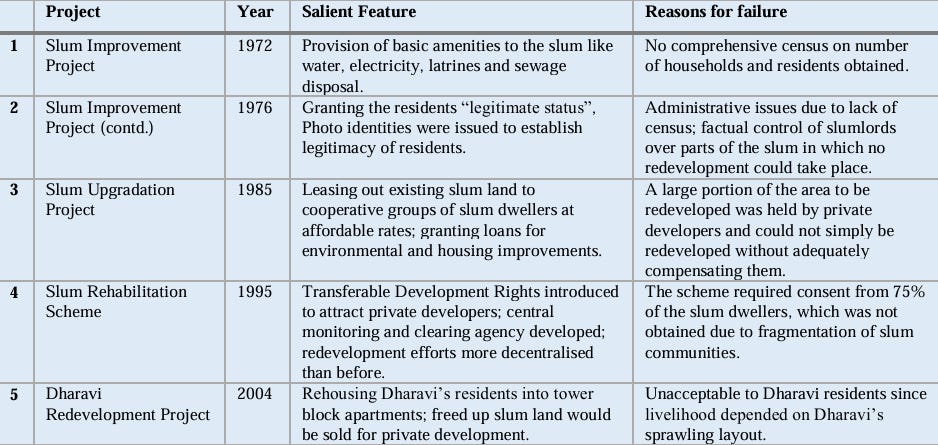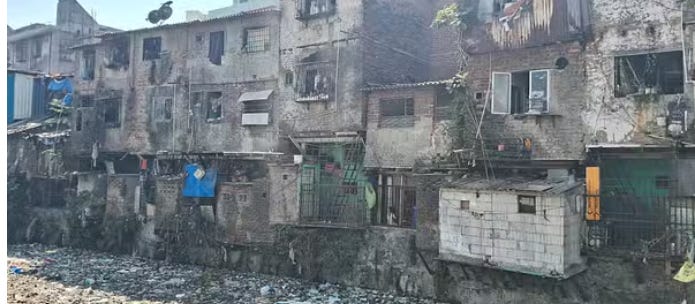Dharavi's Redevelopment: Underdog Slums are Winning the Economy Race
GDP Contributions, Informal Markets and the Future of Asia's Largest Slum
If you have watched the Oscar-winning film ‘Slumdog Millionaire’, you know that it is the story of a boy in the slums of Mumbai going from rags to riches. This newsletter will tell you that Mumbai rags are the less-known riches (not quite literally)!
One of India’s greatest challenges is its ever-growing population which directly results in urbanization and the rise of slums. At the same time, there has been a notable shift in urban development policies across various Asian countries, which is no more about slum removal and relocation, but rather redevelopment and upgradation: Thailand: Baan Mankong program (2003), Vietnam: Vietnam Urban Upgrading Project (2004), Indonesia: National Slum Upgrading Project (2016). Add India to the list too!
More than half of Mumbai’s population lives in slums and in 2004, the Government of Maharashtra (GOM) pledged to transform Mumbai into a world-class city with a vibrant economy and high-quality living standards. This majorly included proposals to redevelop the slums, key attraction being the redevelopment of one of the biggest underdogs of informal economy of Mumbai - Dharavi.
Economy Unveiled aims to present heavily-researched yet easily-digestible financial content! We write about the biggest stories in the markets to help you understand what they mean for you and the world.
Wonder why read us? We are a team of CAs, MBAs, and CFA professionals committed to leveraging the power of research to provide valuable content for our daily readers.
Tune in to our podcast on YouTube. Explore our products here and chat with us on Whatsapp for more details. Subscribe to our newsletter and stay connected!
The glorious Mumbai
Mumbai, the commercial capital of India, generates about 5% of the country’s GDP and contributes a third of its tax revenues. The city is home to most of India’s estimated 70,000 high-net-worth individuals (HNWIs) and is also to Asia’s richest person, Mr. Mukesh Ambani! It ranks 5th highest in global real estate prices but that also means that more than half of Mumbai's residents live in slums - highlighting a deep economic disparity.
Imagine Mumbai like this:
The 25th wealthiest city in the world.
A population of approximately 20 million.
Contributing around 12.92% of the nation’s total GDP.
Over the past few decades, rapid urbanization and industrialization had pushed its population to over 18 million by 2007. This increase in population ended up putting enormous strain on real estate leading to a lack of affordable housings. Coupled with the trends of a huge income inequality, people were pushed to seek shelter in informal settlements and slums like Dharavi.
Welcome to the alleys of Dharavi- Asia’s largest slum!
Dharavi is one of the many slum settlements in Mumbai's mainland - strategically positioned between Mumbai's two main suburban railway lines, the Western and Central Railways, and close to Mumbai Airport.
Imagine it as the exact opposite of The glorious one-
Extremely low rents, sometimes harboring over 20 people living in a single unit.
Open sewers, limited access to clean water.
Unsanitary conditions and poor construction increasing the risk of fires, damage and disease during monsoons.
The people of the slums might not be thriving but surprisingly, the economy is!
Web of a Huge Dynamic Ecosystem
Dharavi is a fully functioning economy consisting of self-employed workers and unregistered organizations working in over 5000 businesses and 15,000 single-room factories in just the area of about 2.39 sq km! Being a thriving hub for businesses, it encompasses the whole gamut of industries including electronics, clothing, suitcases, food production, recycling, leather goods, and pottery. You name it! These products are catering to the international markets including the U.S., Europe, and the Middle East.
"a self-created special economic zone for the poor” - The New York Times
Dharavi's workforce is engaged across various sectors, including pottery, leather production, textiles and garment manufacturing, recycling, and other small-scale manufacturing and services, though the exact percentage distribution remains too challenging to be documented.
In the Kumbharwada area of Dharavi, generations of potters craft ceramic bowls and vases using scraps of clothing from the slum's textile industry. In other parts of it, artisans transform the skins of sheep, goats, and water buffalo into leather. Women in Dharavi can earn around 100 rupees per day by making papadum (a tasty crispy snack!) as per some estimates.
Numbers for nerds: As per a survey by the Maharashtra Social Housing and Action League, Dharavi is home to approximately 49,643 slum dwellers, including 39,208 residential occupants and 10,435 commercial occupants!
Dharavi is Different: Circular and Informal
Circular Economy: The Closed-Loop System
Nothing goes to waste in Dharavi!
A circular economy is an economic system aimed at eliminating waste and continually using resources. In contrasts with the traditional linear "take-make-dispose" economy, it is a Closed-loop system.
Designed to minimize waste and maximize resource efficiency, here materials are reused, repaired, or recycled to extend their lifecycle. In easy words, it means that waste from other industries is a raw material for the industries in this ecosystem.
Too Fin to know! 60% of Mumbai’s plastic waste is recycled at Dharavi! To tell you it's huge, let me take you to London and Tokyo which recycle about 35% and 20% of its waste, respectively!
By the way, sustainable systems are an exciting investment for today and a smart choice for tomorrow. We will help you invest in companies that care about our environment. Click here to check out our product: Environment Social Governance (ESG).
Informal Economy: Invisible enough!
We have been calling Dharavi Informal and now, Invisible too!
An informal economy operates outside government regulations, meaning businesses and workers are not subject to labor laws, taxation, or other formal contracts. So, the small-scale enterprises of Dharavi are neither taxed nor monitored by the government.
Why does this happen? Reason could be anything ranging from rapid population growth to slow industrial growth to rigid labor laws or to even a combination of any of these factors.
I call this economy invisible because it operates beyond the reach of conventional data collection and law enforcement, making it difficult to quantify and legalize. Hence, the activities of this economy are not included in a country's gross national product (GNP) or gross domestic product (GDP). Dharavi's GDP per capita varies based on its labor force size, which ranges from 300,000 to a million workers.
Fin Fact! Mumbai contributes about one-third of India’s tax revenue, which is approximately 50 billion USD annually. Dharavi’s output of 650 million to 1 billion USD could be compared to a significant 1.3% to 2% of Mumbai's total tax contributions!
Dharavi’s metamorphosis: Dharavi Redevelopment Project
Remember how over 5,000 businesses and 15,000 single-room factories are operating in the mere area of about 2.39 sq km! To resolve the issue of overcrowded living conditions, Mumbai government starting back in 1972 came up with an exhaustive list of schemes and initiatives over time, including the ongoing Dharavi Redevelopment Project.

Initially proposed in 2004, politics waved a green flag to the $3-billion Dharavi Redevelopment Project, with the BJP-led Mahayuti coalition’s decisive victory in Maharashtra's assembly elections. The government established the Mumbai Task Force, led by the Chief Minister and Chief Secretary, to oversee what was named the Vision Mumbai project. A Mumbai Development Fund was created, supported by public donors like the World Bank, IMF, UN agencies and others. Dharavi was adopted as one of the first housing development projects under this.
A ‘radical’ makeover of Dharavi was designed by Mr. Mukesh Mehta, the then architect and a project management consultant. Down the line, in November 2022, Adani Group secured the bid to redevelop and change the trajectory of Dharavi. Since then, efforts to radically redesign the area have been ongoing.
Key points:
DRP is a Special Purpose Vehicle formed as a joint venture between the State government and Adani Group (holding an 80% stake in it).
It will use advanced technologies like drones, LiDAR, and mobile applications for surveying, mapping and documentation.
The rehabilitation construction cost is estimated at 23,000 crores.
Implications and Uncertainties
But Dharavi residents may be too skeptical of such state-led redevelopment projects owing to a poor track record of what fortune did it unfold on its people previously. A previous slum rehabilitation project in Dindoshi, Mumbai relocated 2,000 residents to temporary housing, 15 km from their workplaces, increasing their transportation costs. The area lacked proper roads, garbage collection system and water supply for weeks!
The proposed makeover faced criticism for its simplistic approach to the complex demography and livelihoods of slum dwellers. The land allocation system and the categorization of eligible versus ineligible residents under this DRP have also raised eyebrows. Amid all uncertainties, odds appear in favor of the slum economy with the government promising business-friendly provisions like free commercial spaces for small businesses.
But the list of questions is unending!
Will the project meet the time and budget constraints?
Will the issues of corruption and illegal transactions be effectively addressed?
Will it lead to a boost or a slowdown in the annual yield and trade in this ecosystem?
Far into the future, will the people of Dharavi rebuild their trade connections to keep thriving in the shadow of informal trade system? Or will it lead to formalization of this informal sector?
A take on Dharavi’s Formalization
Why formalize? Over half of India's economic activity occurs in the informal sector. We already discussed how informal economies are not included in a country's GDP and that is why policymakers across the world strive to formalize unregistered businesses to address such issues.
In the Union Budget speech of February 1, 2017, the finance minister highlighted India's low tax-to-GDP ratio and insufficient direct tax collection relative to income and consumption patterns. For example, out of 5.6 crore informal enterprises, only 1.81 crore filed tax returns.

To address this, FICCI conducted a study on India’s informal economy and developed a policy framework for promoting formalization. Methodology involved surveying informal enterprises in five industrial clusters—Jalandhar (sports goods), Moradabad (brass), Kanpur (leather), Jaipur (gems & jewelry), and Coimbatore (textiles).
Survey analysis concluded that most people see registration as unnecessary since it is not legally enforced and offers limited advantages. Nearly 79% of respondents believe registered firms gain no significant benefits, while 68% think there are no serious legal repercussions for remaining unregistered.
Learn from the World: Inspectorates in Chile and Peru offer training to micro and small enterprises (MSEs) to help them comply with legal requirements. In Brazil, created a separate portal individual entrepreneurs to register to customize the process for them.
If policymakers draw the right lessons from this, I suggest that they must craft a credit support system to help small scale industries enter the organized sector. Formalizing this economy requires granting legitimacy to street vendors and strict enforcement of existing laws at state and municipal levels.
Since as per the survey, many businesses would formalize if sufficient subsidies were offered, challenges like lengthy administrative processes, fear of penalties, and high costs may not be impossible to manageable with a tailored approach!
Last Words.. A recent UN-HABITAT report predicts that rural-to-urban migration will continue to accelerate in developing countries over the coming decades, leading to a growth in urban slum populations. If DRP proves to be a success, it could serve as a model for reengineering other urban slums in India and beyond.
But it is for the time and news to tell.
Until then, toodles!




wow, this deserves a video.
Interesting read.